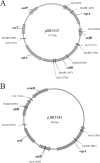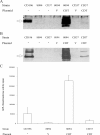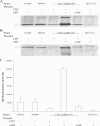Binary toxin production in Clostridium difficile is regulated by CdtR, a LytTR family response regulator
- PMID: 17693517
- PMCID: PMC2168464
- DOI: 10.1128/JB.00731-07
Binary toxin production in Clostridium difficile is regulated by CdtR, a LytTR family response regulator
Abstract
Clostridium difficile binary toxin (CDT) is an actin-specific ADP-ribosyltransferase that is produced by various C. difficile isolates, including the "hypervirulent" NAP1/027 epidemic strains. In contrast to the two major toxins from C. difficile, toxin A and toxin B, little is known about the role of CDT in virulence or how C. difficile regulates its production. In this study we have shown that in addition to the cdtA and cdtB toxin structural genes, a functional cdt locus contains a third gene, here designated cdtR, which is predicted to encode a response regulator. By introducing functional binary toxin genes into cdtR(+) and cdtR-negative strains of C. difficile, it was established that the CdtR protein was required for optimal expression of binary toxin. Significantly increased expression of functional binary toxin was observed in the presence of a functional cdtR gene; an internal deletion within cdtR resulted in a reduction in binary toxin production to basal levels. Strains that did not carry intact cdtAB genes or cdtAB pseudogenes also did not have cdtR, with the entire cdt locus, or CdtLoc, being replaced by a conserved 68-bp sequence. These studies have shown for the first time that binary toxin production is subject to strict regulatory control by the response regulator CdtR, which is a member of the LytTR family of response regulators and is related to the AgrA protein from Staphylococcus aureus.
Figures





Similar articles
-
Clostridium difficile binary toxin CDT: mechanism, epidemiology, and potential clinical importance.Gut Microbes. 2014 Jan-Feb;5(1):15-27. doi: 10.4161/gmic.26854. Epub 2013 Oct 31. Gut Microbes. 2014. PMID: 24253566 Free PMC article. Review.
-
CdtR Regulates TcdA and TcdB Production in Clostridium difficile.PLoS Pathog. 2016 Jul 14;12(7):e1005758. doi: 10.1371/journal.ppat.1005758. eCollection 2016 Jul. PLoS Pathog. 2016. PMID: 27414650 Free PMC article.
-
Genetic relatedness of Clostridium difficile isolates from various origins determined by triple-locus sequence analysis based on toxin regulatory genes tcdC, tcdR, and cdtR.J Clin Microbiol. 2008 Nov;46(11):3703-13. doi: 10.1128/JCM.00866-08. Epub 2008 Oct 1. J Clin Microbiol. 2008. PMID: 18832125 Free PMC article.
-
Binary toxin locus analysis in Clostridium difficile.J Med Microbiol. 2011 Aug;60(Pt 8):1137-1145. doi: 10.1099/jmm.0.028498-0. Epub 2011 Apr 1. J Med Microbiol. 2011. PMID: 21459907
-
Binary Clostridium difficile toxin (CDT) - A virulence factor disturbing the cytoskeleton.Anaerobe. 2018 Oct;53:21-29. doi: 10.1016/j.anaerobe.2018.03.001. Epub 2018 Mar 7. Anaerobe. 2018. PMID: 29524654 Review.
Cited by
-
Clostridioides difficile infection: traversing host-pathogen interactions in the gut.Microbiology (Reading). 2023 Feb;169(2):001306. doi: 10.1099/mic.0.001306. Microbiology (Reading). 2023. PMID: 36848200 Free PMC article. Review.
-
Clostridium difficile binary toxin CDT: mechanism, epidemiology, and potential clinical importance.Gut Microbes. 2014 Jan-Feb;5(1):15-27. doi: 10.4161/gmic.26854. Epub 2013 Oct 31. Gut Microbes. 2014. PMID: 24253566 Free PMC article. Review.
-
Clostridium difficile infection: new developments in epidemiology and pathogenesis.Nat Rev Microbiol. 2009 Jul;7(7):526-36. doi: 10.1038/nrmicro2164. Nat Rev Microbiol. 2009. PMID: 19528959 Review.
-
Epidemiology and virulence-associated genes of Clostridioides difficile isolates and factors associated with toxin EIA results at a university hospital in Japan.Access Microbiol. 2019 Dec 19;2(2):acmi000086. doi: 10.1099/acmi.0.000086. eCollection 2020. Access Microbiol. 2019. PMID: 34568752 Free PMC article.
-
Defining the Roles of TcdA and TcdB in Localized Gastrointestinal Disease, Systemic Organ Damage, and the Host Response during Clostridium difficile Infections.mBio. 2015 Jun 2;6(3):e00551. doi: 10.1128/mBio.00551-15. mBio. 2015. PMID: 26037121 Free PMC article.
References
-
- Aktories, K., and A. Wegner. 1992. Mechanisms of the cytopathic action of actin-ADP-ribosylating toxins. Mol. Microbiol. 6:2905-2918. - PubMed
-
- Barbut, F., B. Gariazzo, L. Bonne, V. Lalande, B. Burghoffer, R. Luiuz, and J. C. Petit. 2007. Clinical features of Clostridium difficile-associated infections and molecular characterization of strains: results of a retrospective study, 2000-2004. Infect. Control Hosp. Epidemiol. 28:131-139. - PubMed
-
- Borriello, S. P. 1998. Pathogenesis of Clostridium difficile infection. J. Antimicrob. Chemother. 41(Suppl. C):13-19. - PubMed
-
- Boyer, H. W., and D. Roulland-Dussoix. 1969. A complementation analysis of the restriction and modification of DNA in Escherichia coli. J. Mol. Biol. 41:459-472. - PubMed
Publication types
MeSH terms
Substances
Associated data
- Actions
Grants and funding
LinkOut - more resources
Full Text Sources
Other Literature Sources
Molecular Biology Databases

